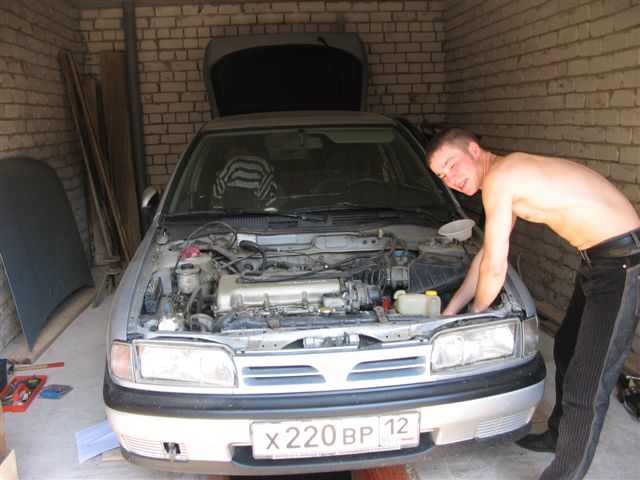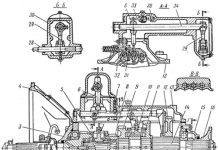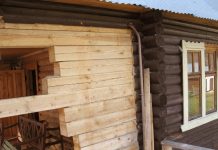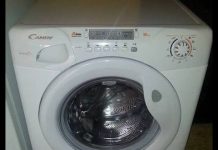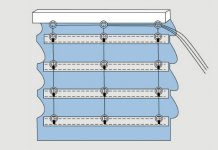In detail: do-it-yourself nissan p10 repair from a real master for the site my.housecope.com.
How I repaired the upper pendulum arms (saga)
If you don’t have extra $ in your pocket and your hands grow from where you need to, and you also have the necessary tools and free time, then the following proven repair option is offered:
Step 1. You take 50 rubles and go to KEMP. There you buy eight “VAZ pendulum bushings” made of black plastic for 40 kopecks each, two sets of brass “connecting rod bushings” for Tavria at 13 rubles 50 kopecks per set (4 bushings included) and eight “worm shaft seals for VAZ 01-07 ”metal outside for 2 rubles apiece. Total spare parts for 46 rubles 20 kopecks for the repair of 2 suspension arms.
Step 2. With all this stuff back to the garage. There from the purchased parts you make repair kit. We take seals. Oil seals in Nissan levers have a size of 38x20x6. The seals you purchased have a size of 37x19x10 (the domestic industry does not seem to produce the required size). In addition, they are iron on the outside. They must be brought to condition as follows:
- we put the stuffing box on a flat metal surface with the spring down and apply a series of light blows with a hammer evenly around the entire circumference so that the stuffing box from a flat cylinder with an outer diameter of 37 mm and a height of 10 mm turns into a barrel with a diameter of 38 mm and a height of 8 mm;
- we take the bushings of the VAZ pendulum and separate the “hat” and “cylinder”.
Step 3. We remove levers. To do this, you need a head for 17 with a knob and an extension, a key for 17 and WD40. Raise the desired side and remove the wheel. We clean all the nuts from dirt and moisten with WD40 for 15 minutes. Nuts: one on the near side of the arm, one on the far side, and 2 nuts and 2 bolts securing the bracket to the body, which includes the far end of the arm. Unfortunately, the bracket will have to be unscrewed, because. the bolt from the far part of the lever is removed towards the passenger compartment and, with the bracket screwed on, rests with the head against the body. When reassembling, do not forget to put it the other way around. Two bracket nuts are located outside (in the wheel arch - lower) and the top two - inside the engine compartment and are rectangles with threaded holes placed in pockets. All nuts are anodized inside and should unscrew after wetting under the influence of the head and amplifier. Yes! First, unscrew the nut and remove the bolt on the near side of the lever. Disconnect the upper and lower arms. We take the upper arm and swing it from the stern to the bow of the car. If it wobbles, it needs to be repaired. If not, don't.
| Video (click to play). |
Step 4. Repairing levers. We remove the old oil seals (I had all of them, except for one, whole and elastic, at the age, however, of 7 years). We take out the “piece of iron” (hereinafter, the kingpin) (see figure) and pick out the worked plastic bushings with a knife. We wipe the inside of the cylinder with a rag and lay graphite grease or SHRUS grease. In the middle of the cylinder inside there is a separating rubber seal. He doesn't give a damn about us. We also lubricate the “pieces of iron” with graphite grease and put on the ring from the pendulum bushing and behind it the connecting rod bushing until it stops. Again, grease everything with graphite grease. The resulting assembly unit is inserted into the cylinder. She enters tight and half under the influence of assault. We help with a hammer for the other half. We take the stuffing box and smear it on the outer ring with sealant, then insert it with the spring out.
Step 5. We collect everything back and enjoy the unprecedented silence of the suspension and the absence of bumbling on bumps.
In conclusion, I can say:
- that the corrugated cover on the front shock absorber fits from 08 one to one, if a pair of corrugations is cut off from below;
- you can immediately rush to repair your levers, or you can wait a month, starting today, until I publish the test results.
THINNESS #1.Native oil seals can be carefully removed safe and sound. For me, they are like new. This is done like this: flat screwdrivers are taken - narrow, thin and ordinary. The spring is removed from the stuffing box and a narrow screwdriver is inserted between the inner stuffing box seal and the lever pivot inward. Then the screwdriver is tilted as parallel as possible to the plane of the stuffing box and its blade is driven under the edge of the stuffing box from the inside. Turning the screwdriver, lift the edge of the gland. Then we move the screwdriver further along the circumference and turn it again. So perhaps more often around the perimeter. If this is done rarely, the plane of the stuffing box will be broken. If, after the described procedure, the stuffing box has risen, but does not come out, you need to help it in the same way with an ordinary screwdriver.
THINNESS #2. Lever cylinders, which are closer to the body, are longer than those farther away. Therefore, to repair one lever, you will need 5 bronze bushings - 2 for the outer cylinder and 3 (1.5 + 1.5) for the inner one.
THINNESS #3 (the most important). Because bronze bushings are split and when they are mounted, their seam diverges by 1-1.5 mm, then there is some eccentricity of the pivots in relation to the lever cylinders. If this very eccentricity on one side of the cylinder does not coincide with “E” on the other side of the cylinder, then a slight misalignment of the pivots occurs relative to each other. This misalignment slightly interferes with the insertion of the bolt during assembly and, worst of all, causes this bolt to get caught in the kingpins when tightened. Considering that the bolt should not also rotate relative to the lower pendulum arm, we get an absolutely rigid structure with a strong tightening, which, of course, becomes loose at the beginning of operation and starts to creak terribly. From here there are two ways out - simple and more difficult.
Simple. When fitting bushings and their halves, it is necessary that the seam matches. When inserting pins with bushings on both sides of the cylinder, it is necessary that the seams on the left and right pins match, i.e. so that the eccentricity of both pivots is the same.
More difficult. Each sleeve must be cut into three rings and put on the kingpin so that the angle of the seams is 180 degrees. Then, perhaps, the eccentricity will disappear altogether.
THINNESS #4. Before inserting the glands into place, the assembly must be developed. To do this, a regular bolt is inserted into the king pin with the lever removed, and clamped with a nut. The lever is clamped in a vice and with a wrench for the bolt we turn the kingpin on the bushings. The criterion for the development of the knot is the turning of the pivots on the bushings with a key 30 cm long (from the driver's set) with one hand (and not leaning with the whole body). It took me a bit to grind the bushings on the grinding wheel to achieve the desired effect. If the node is not developed, then the consequences are as in subtlety No. 3. I did all this 3 weeks ago. Since then, it has rained, there was mud, then frost hit. First trips on salt. The refurbished units work just perfect. The suspension has become noticeably quieter, especially over small bumps. It pleases when you remember that there are ice pits and growths (bumps) ahead on poorly cleaned roads.
20000 later. Everything is OK, except for domestic oil seals. Where he inserted the domestic oil seal, it creaked again. After disassembly, it turned out that the domestic oil seal is poorly adapted to domestic salt on the roads (unlike the English one). The rubber has hardened, and the coupling spring has turned into separate cylinders of rust. Dirt got inside. Dismantled, lubricated everything again, put new seals, only now filled them with Movil from the outside. Let's see what happens this time.
Group: Moderators
Posts: 901
Registration: 20.6.2008
From: Moscow
User #: 10441
Car: GAZ-3110 “Volga” 2004
1 Nissan Primera 1990-1999
Models covered in this manual: Nissan Primera gasoline models: 4-door Sedans, 5-door Hatchbacks and Station Wagons, including all limited edition 1597cc and 1998cc engines.
Models with a diesel engine are not considered, as well as the new Primera model, put into production since September 1999.
B/W + color tabs.
2 Nissan Primera P10W10Avenir
Description: This manual provides the most comprehensive description of the maintenance and repair of P10 and W10 series vehicles. The manual is based on the factory repair manual and is applicable to a wide range of body modifications, engines, gearboxes, as well as to various countries of destination (Europe, Japan, etc.). Engines GA16DS, SR20Di, SR20De, SR20DE, CD20.
3 Nissan Primera 1990-1999
Description: The book covers models with 1.6 / 2.0 liter gasoline engines and 2.0 liter diesel engines. Operations for the device, repair and maintenance of components and mechanisms of the car are considered with illustrations and photographs. Wiring diagrams and instruction manual included. For a wide range of consumers.
Petrol engines:
GA16DS 1.6 l. / 71 kW (97 hp) Nikki 21L carburetor
GA16DE 1.6L/75KW (102HP) Nissan multipoint injector
SR20Di 2.0L/92KW (125HP) Nissan singlepoint injector
SR20De 2.0 l. / 96 kW (131 hp) Nissan multipoint injector
SR20DE 2.0 l. /110kW(150hp) Nissan multipoint injector
Diesel engine:
CD20 2.0 l. / 55 kW (75 hp)
Post has been edited 100nx – 9.11.2011, 23:17
The Nissan Primera is a family of D-class cars with front-wheel drive and all-wheel drive. Available in sedan, hatchback and station wagon body styles.
The first generation Nissan Primera was first introduced in February 1990. In the fall of 1990, an all-wheel drive modification appeared. The first generation Primera was produced in the P10 body - a 4-door sedan and a 5-door hatchback, while station wagons had a W10 body index and had practically nothing to do with a sedan and a hatchback. Yes, they have a similar interior, the same engines are used, but they are completely different cars. In addition, the W10 was produced (from 07.90 to 01.98), one might say, in their historical homeland - in Japan, and the P10 - in the UK, and this says a lot: technology, materials, personnel.
Primera cars of the early 90s are characterized by a calm appearance. Despite the external similarity, the station wagon differs significantly from the hatchback sedan in design. The main difference is the three-link front suspension, which gives the P10 legendary stability and control. The station wagon uses McPherson and a dependent beam, which are more reliable and durable, so the station wagon rear suspension is almost indestructible. However, this makes the workhorse (station wagon) steer noticeably worse than the Primera in sedan and hatchback bodies, a characteristic feature of which is very precise steering. The multi-link suspension here is stiff, but moderately comfortable. Thanks to its sophisticated construction, the Primera doesn't tip over in sharp corners, and bumps in the road are handled with far less cabin rumble than any of its competitors. A slight rumble is present, but there is no separation from the road surface, yaw and other “pleasures”. It is precisely the clear and predictable behavior on the road that many owners call the first advantage of a car.
Several engines were offered for the car. Gasoline GA16DS - 1.6 with a capacity of 90 hp. (carburetor), and in 1993 it was replaced by GA16DE - the same 1.6, but with distributed injection with a power of 100 hp. SR20DI - mono-injector 2.0 with a capacity of 115 hp, from the 93rd SR20DE -125 hp, later 135 hp The power of 2-liter ones is indicated as base, but the real one is very approximate and not stable, since when breaking through the VINs of cars of different years, there is often a mention of reduced engine power. Diesel LD20 (75 hp) was produced until April 1996. The engines are quite reliable and, with proper operation and timely maintenance, are able to “go out” before overhaul up to 200-300 thousand km. Carburetor versions of engines often experience jerks during operation due to a tendency to misalignment and inconsistent work with the catalyst.
Gearboxes were used 5-speed manual and 4-speed automatic. The first-year Primera manual transmission has a bad reputation as over time, fifth gear synchronizers become loose. As for the “automatic”, it does not cause difficulties in operation.
The brakes are quite clear and informative. All cars were equipped with front disc brakes, rear - disc (SR20Di, SR20DE and part of GA16DE, CD20) and drum type (GA16DS and part of GA16DE, CD20). Most cars (except GA16DS) are equipped with ABS.
In mid-1996, a new Primera series appeared on the conveyor, with the P11E index. This model was developed exclusively for the European market (hence the letter E). Notably, all body styles were now produced in the UK, including the WP11E station wagon. According to the designers, the car has been significantly redesigned. More than 600 innovations have been applied in the new model, however, this applies mainly to small things. The rear part of the P11 suspension has changed, now it is made, as in the W10 - a beam with a Scott-Russell mechanism, and only the lower arm has changed in front (or rather, one of its silent blocks). The handling of the car, especially its cornering behavior, has become exceptional. The developers of the car managed to bring the weight distribution of the car along the axes closer to the ideal one. However, in the new P11, the new rear suspension is more likely to break down than in the P10.
Equipment options remain the same as the predecessor - SLX and GT. GX also appeared (the poorest, replacing LX) and SE (the richest: 4 pillows, leather, sunroof, air conditioning, music, etc.). The remaining names are secondary, do not carry significant information and serve purely marketing purposes.
The interior probably contains half of the promised 600 changes - in the upholstery of the doors, the plastic of the dashboard. Now the interior has become two-tone, with a dark top and a light bottom. The seats have also increased in size, their backs have become a little higher. Sometimes there is leather trim.
The engines have been updated but remain the same. Their characteristics have changed somewhat. In the spring of 1997, the GT (sedan) version was released with a 2-liter 16-valve engine with 150 hp. Externally, the redesigned engine is distinguishable by the red head. Changes in the brake system have affected, in particular, the electronic brake force distribution system that controls the ratio between the front and rear discs, as well as the vacuum brake booster, brake master cylinder and ABS.
In September 1999, a new generation of Nissan Primera models with body index P11-144 entered production. Production of the Nissan Primera is now concentrated at Nissan's flagship plant in Sunderland, UK. The exterior of the car and the interior, made in a sporty-executive style, were developed in the European technology center of Nissan company under the guidance of English designer Dale Gotsel. The lines of the hood have been completely changed: the protruding chrome edges of the radiator grille flow smoothly into the hood with a modified, clear profile. Its aggressive style is transferred to the bumper with air intakes and wide-spaced fog lamps. The lowered bumper looks like part of the body, its lower part improves the aerodynamic characteristics of the car and smoothly passes into the thresholds, visually reducing its height, so that the silhouette of the car has become more squat. The headlights are equipped with xenon lamps, giving twice as much light as standard halogen ones. The sporty styling of the front is echoed by the raised edge of the rear spoiler and the soft contours of the bumper, which looks like a single unit. Elegance is emphasized by the line of the trunk and the bulging “three-dimensional” taillights with black and red lenses hidden by smoked plastic.
The elegance, sportiness and technology of the Primera's exterior is also reflected in the car's interior. The front panel is made in two colors, with a dark top and a light bottom. The redesigned front seats have received new upholstery materials, their wider and higher cushions emphasize the luxury and sporty style of the new car. The car is offered with four trim levels: Comfort, Sport, Lux, Elegance (the last one is the most sophisticated). Four different types of fabric are used for the interior, and leather trim is also available for the most complete models.The newly shaped gear knob is made of aluminum or wood in the Sport and Elegance trim levels. It is also possible to finish the steering wheel with leather and wood.
Each configuration can be equipped with any of the engines: gasoline with a volume of 2.0, 1.8 and 1.6 liters or a two-liter turbodiesel. The new 1.8-liter gasoline engine, which received the QG18 index, exceeds the European Euro-4 requirements, which will come into effect in 2005, in terms of exhaust gas levels. It was not based on the SR18 known on the Japanese market, but something new gas distribution phases. Two-liter versions received CVTs as an option. A new manual gearbox is installed on all of the listed options, and with a two-liter gasoline engine, a CVT or CVT M-6 variator can be equipped. With any engine and trim level, the car is offered in one of three body styles: sedan, hatchback and station wagon.
Safety is one of the main areas of improvement for the new generation of Primera. New technologies that have made the Primera a leader in safety include a class-first mechanical brake assist, new headlights, new larger side airbags and the ISOFIX child seat attachment system. Brake Assist is the first system of its kind to be installed in a D-segment vehicle. Like its counterpart in luxury cars, it helps drivers of all skill levels to brake as efficiently as possible using ABS. Together with quad-channel ABS and electronic brake force distribution and Brake Assist, the new Primera is equipped with ventilated brake discs with a diameter of 280 mm, which were previously equipped only on the GT version. The brake force distribution system precisely controls the balance between the front and rear brakes. These innovations, together with the improvement of the brake master cylinder and brake booster, have made the brake system of the Examples more powerful and controllable.
The climate control system is designed to turn on with a single push. The driver only selects the temperature - and the climate control system itself regulates the microclimate in the cabin, taking into account changes in the outside temperature and the degree of heating of the cabin by sunlight. All that the driver needs to do is to correctly direct the jets of air entering the passenger compartment. You don't need to adjust the fan speed or temperature.
The new generation of the 2002 Nissan Primera, the Primera sedan and station wagon, has been produced since mid-December 2001 at the renowned Nissan Motor Manufacturing (UK) Ltd. in Sunderland, UK. At the beginning of the summer of 2002, the production of a 5-door hatchback, created specifically for Europe, began. The high-tech Primera retains all the shapes of the concept shown in Paris in 2000. Its distinctive "monoform" represents a bold change in three-box styling and sets a new standard in the class.
The new generation of the Nissan Primera is perhaps the most revolutionary innovation in the middle class in the history of the company. Creating a unique personal style was the main task when, in 1997, work began on the third generation of Primera. Stefan Schwarz, Chief Designer, Nissan Design Europe, the man behind the new Primera's exterior, describes the car's design as best representing the shift in concept and form expression. “Our initial idea was to move away from the stereotypes of creating a sedan concept. The design of the sedan is traditionally very conservative, with a strict separation of the engine compartment, passenger compartment and luggage compartment. In order to provide more spaciousness and comfort in the cabin, we approached the exterior design starting from the interior of the cabin, i.e. began to develop forms from the inside. Our monoform silhouette combines the functionality of a roomy cabin with a unique profile that is easily recognizable from a distance,” he says.
The range of engines has not changed much, with a new 2.0-liter gasoline engine added to the upgraded 1.6-liter and 1.8-liter engines, as well as Nissan's latest development - a 2.2-liter turbodiesel engine with direct injection systems and Common Rail ”, providing good power characteristics and lower fuel consumption.
The new Primera is powered by the familiar 1.6-litre QG16 engine, which now delivers 80 kW (109 hp) at 6,000 rpm. and 144 Nm of torque at 4,000 rpm The electronically controlled throttle ensures smooth transmission of the increased torque achieved by the variable valve timing system. An aluminum manifold has replaced the traditional cast iron manifold, resulting in an increase in torque for greater “elasticity” of movement, together with an increase in the length of the exhaust manifold.
The more powerful 1.8L QG engine also features a dual aluminum exhaust manifold and variable valve timing for increased torque and improved throttle response, while the flywheel and low-noise chain reduce noise levels. This engine delivers 85 kW (116 hp) at 5600 rpm and 163 Nm of torque at 4000 rpm.
The new 2.0L QR20 engine features a stiffer frame (ladder) cylinder block and a compact balancer system for superior smoothness and quiet operation. The use of lighter parts, a low-noise chain and a plastic valve cover allows this engine to come as close as possible to the performance of a 6-cylinder engine. Its maximum power is 103 kW (140 hp) at 6000 rpm and torque is 192 Nm at 4000 rpm.
The 16-valve, 2.2L YD22 turbo-diesel engine with two overhead camshafts and “Common Rail” technology is similar to the engine installed in the recently launched X-Trail car. With an optional turbocharger and optional variable injection duration, it achieves 93 kW (126 hp) at 4,000 rpm and 280 Nm of torque at 2,000 rpm.
Engines up to 2.0 liters. are standard equipped with a 5-speed manual transmission, and for a 1.8-liter engine, a 4-speed automatic transmission is available. Both new engines are offered with a 6-speed manual transmission, and for a 2.0-liter gasoline engine. in addition, it is possible to install a Hypertronic CVT-M6 variator with the possibility of manual gear shifting.
Combining the best features of the MacPherson strut suspension and the double wishbone system, the multi-link front suspension uses a specially insulated subframe to provide smooth ride and comfort while reducing noise and vibration.

